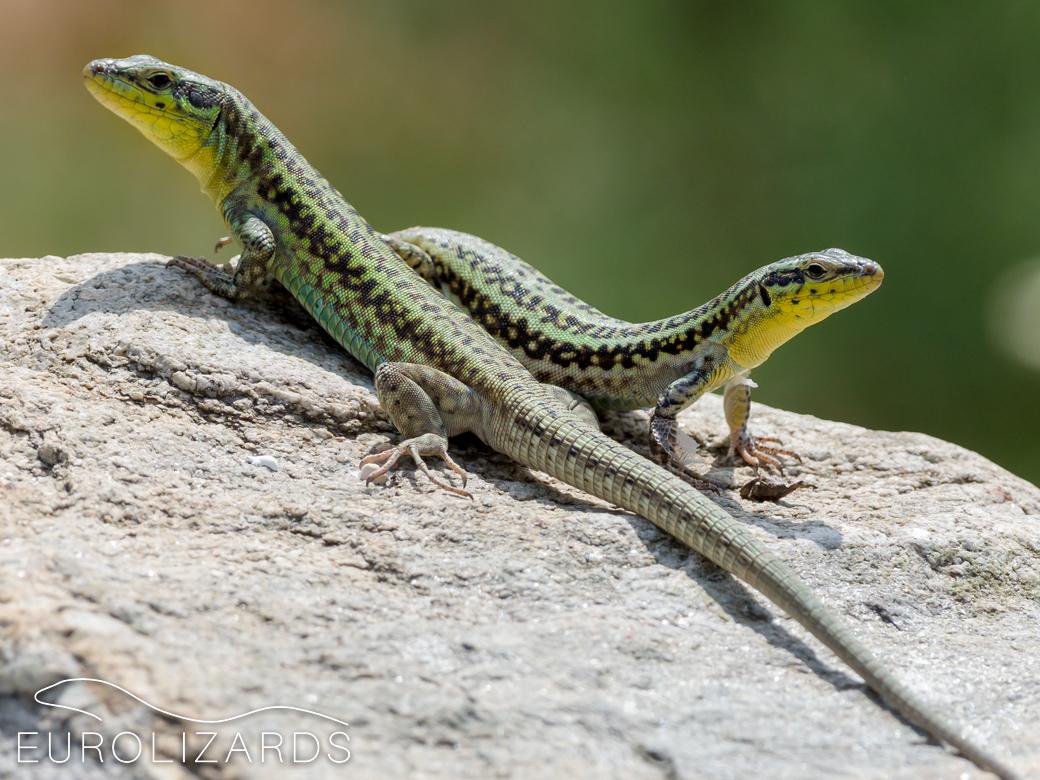Podarcis erhardii - Erhard's Wall Lizard

The Aegean with its numerous islands is one of Europe's most productive biodiversity labs - and Erhard's Wall Lizard is one of its masterpieces! This highly variable species has successfully populated wide parts of the southern Balkans and numerous Aegean Islands and developed a remarkable variability. In the early 20th century, ambitious herpetologists have described about 20 subspecies – in particular for the Islands. However, most of them are questionable. So, an in-depth taxonomic review of this species is an unavoidable but challenging task for future research.
Currently, according to available genetic data, the different morphs may be clustered into the following preliminary groups*:
Mainland:
- Podarcis erhardii riveti: Bulgaria, Macedonia, Serbia, Kosovo, Northern Greece (possibly including subsp. ruthveni from Northern Sporades),
- Podarcis erhardii livadiacus: Attika, Evia and north-eastern Peloponnese.
Aegean Islands:
- Western Aegean – western Cyclades (Sifnos and Serifos and Kithnos),
- Central Aegean – numerous islands of the central Cyclades including Tinos, Mykonos, Naxos, Paros, Amorgos,
- Eastern Aegean – eastern Aegean Islands (Anafi, Astypalea and several uninhabited islets).
As some future species split seems likely, it is worth having a closer look at these groups, subsequently.

Podarcis erhardii riveti

This subspecies shows an olive-greyish back colouration and has no dark vertebral line. The underside may be whitish, yellow or orange in males. It is found from sea level up to 1400 m (Mt. Ossa). The distribution area of Podarcis erhardii riveti covers the southern Balkans from southern Serbia to Central Greece. In its range, it overlaps with the following species:
- Podarcis muralis: this species may look similar to Podarcis erhardii riveti. But Podarcis muralis frequently shows a dark vertebral line which lacks in Podarcis erhardii riveti. Where both species co-occur, Podarcis muralis occupies more humid micro-habitats.
- Podarcis tauricus and Podarcis ionicus differ from Podarcis erhardii riveti by their green colouration and the unspotted labials.
Subsp. ruthveni from Northern Sporades looks similar.
Podarcis erhardii livadiacus

This beautiful subspecies shows a "golden" glance with a fine dark wave pattern. Males may have prominent blue outer ventral scales and intensively red or orange undersides. This lizards seem to be rather rare and local. They seem to have a preference for mountainous habitats (on Evia and Peloponnese they live in altitudes above 1000 m) – but there also have been lowland records.
It may co-occur with the following Wall Lizard species:
- Podarcis muralis: this species may look similar. Usually, Podarcis muralis is darker brownish and frequently shows a dark vertebral line which lacks in Podarcis erhardii livadiacus. Where both species co-occur (e.g. on Evia), Podarcis muralis occupies more humid micro-habitats.
- Podarcis tauricus and Podarcis ionicus differ from Podarcis erhardii riveti by their green colouration and the unspotted labials.
- Podarcis peloponnesiacus & Podarcis thais: On Peloponnese, both species co-occur. In particular, females may look very similar. However, Podarcis erhardii frequently has dark spots on the labial scales which lack in Podarcis peloponnesiacus and Podarcis thais. Furthermore, Podarcis peloponnesiacus and Podarcis thais frequently show a dark vertebral line, which lacks in Podarcis erhardii.

Western Aegean group

The lizards of the Western Cyclades are quite variable: On Serifos, males as well as females have strinking yellow throats; on Sifnos, they have whitish throats and on Kithnos, they show dark spots on the throats.
As on these islands Podarcis erhardii is the only small Lacertid it may hardly be confused with other species. Juvenile Lacerta trilineata hansschweizeri on Serifos may also show yellow throats but they frequently have characteristic light dorsolateral and vertebral lines.
Central Aegean group

The lizards of the Central Cyclades are frequently colourful with green backs and reddish or yellow throats. They may resemble to those on the Western Cyclades, but there seem to be genetic differences.
As they are the only small Lacertids within their distribution area, they cannot be confused with other species. Juvenile Lacerta diplochondrodes (e.g. on Naxos) may also show yellow throats but they have characteristic light dorsolateral and vertebral lines.

Eastern Aegean group

The Wall Lizards of the eastern Aegean Islands significantly differ from those on the central Cyclades: The frequently show a reduced colouration, often greyish or brownish, with short limbs and pointed snouts. Amazingly, they were able to establish populations on several small uninhabited islets which are separated from the Central Cyclades by water depths of several hundred meters. These "deep water" populations seem to the more ground-dwelling, compared to their relatives on the Cyclades. Evolution is still going on here - fascinating!
The eastern distribution limit of this group is marked by the Mid Aegean Trench (with two exceptions, see below). East of this, Podarcis erhardii is replaced by the genus Anatololacerta (e.g. Rhodos, Nisyros).
Being the only Lacertids within their range, they cannot be confused with other species.



* Our structure of five groups is based on genetic anaysis by POULAKAKIS et al:
POULAKAKIS, N. & LYMBERAKIS, P. & VALAKOS, E. & ZOUROS, E. & MYLONAS, M. (2005) - Phylogenetic relationships and biogeography of Podarcis species from the Balkan Peninsula, by bayesian and maximum likelihood analyses of mitochondrial DNA sequences. - Molecular Phylogenetics and Evolution, 37 (3): 845-857.

EUROLIZARDS - The Home of European Lizards! © Birgit & Peter Oefinger
